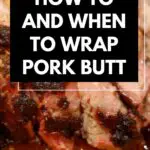Choosing the right cut of meat can actually make or break a meal, and today’s comparison is between butt vs shank ham.
The truth is that everyone has their own opinion on which is best, particularly when it comes to the butt vs shank ham debate.

The thing here is that the choices seem unlimited—butt or shank? Boneless or bone-in?
For a lot of people, a holiday meal is not complete without a gorgeous, spice-filled, savory, and salty ham as the centerpiece.
You should read through to learn all you need to know to make the right choice if you are wondering which one you should choose for the perfect meal.
What is Ham?
Ham is obtained from the back legs and thigh area of a pig.
Several grocery stores sell them in sections, given that a whole ham is a large piece of meat that weighs around 18 to 20 pounds.
Ham sells both bone-in and boneless. Also, keep in mind to keep the hambone to flavor stews, greens, and soups.
And the three most common cuts of ham include butt end, ham shank, and center slice.
However, I will be talking about butt ends and ham shanks in this guide.
Butt Ham vs Shank Ham
There are two different types of pork that are categorized under “shank,” and they include butt and shank.
Butt hams are normally available at grocery stores and are sold with the bone still attached.
Meanwhile, the shank is the part of the pig that runs from the shoulder down to the hip.
It is normally sliced into smaller pieces and used in soups, stews, and other dishes where its flavor will be cherished.
The shank is also referred to as “the knuckle” thanks to its shape.
Just look for one that says “butt” on the package if you want to buy a whole butt ham.
However, if you don’t see this word anywhere, then you can check out the back label to ensure that there is no information about the bone being removed.
You can also ask your butcher if they sell them. You also have the option of looking for packages that say “shank” if you want to get a shank.
That being said, you might also have to ask your butcher to tell you what type of shank you are getting; that way, you can choose the right one.
Difference Between Shank Ham and Butt Ham
Butt ham is obtained from the top portion, and it can often serve so many people due to the fact that it is so much leaner.
On the other hand, shanks are obtained from the pig’s lower legs and have a single bone running along the length of the leg.
The meat is fatty and easy to carve, thanks to the position of the bone.
Overall, shanks have a pleasant appearance. That being said, butt ham wins if you choose leaner meats.
With all that being said, the shank often carves much nicer and comes with a much nicer appearance, so when it comes to choosing which meat to serve up at a dinner party, shanks win.
However, keep in mind that there will be more fat to cut off.
Identifying Butt or Shank Ham
Normally, butt hams are smaller compared to shank hams.
The butt ham has a rounded edge, which actually makes it a lot easier to identify and differentiate from the shank.
As previously mentioned, the meat is a lot leaner on this cut of ham, but the downside to this is that the shape makes carving more difficult.
The shank section of the ham actually has a kind of funnel shape, and this is due to the fact that the cut contains a section of the femur as well as the shank bone.
As a consequence, the meat has so much more flavor but can be tougher to chew compared to the butt section of the ham.
With all that being said, there are pros and cons to both cuts of ham, and it can be quite the task when it comes to choosing which one works best for your BBQ.
Serving Sizes
The recommended ham serving, according to the USDA, is one-fourth of a boneless ham serving or one-third or half pound of the bone-in ham version.
However, a lesser quantity of ham is perfect if the dinners include children.
You should understand that you can’t serve too much given the healthy effect, specifically whenever you need to serve a large audience at the table.
You won’t want the diners to be unsatisfied, so you can’t serve too little.
So, I suggest that you shop for the right quantity to prevent waste or unhealthy food, and you can do this by considering the number of adults and children to be served.
To make up for the bone content, adults get just about a pound of bone-in ham per serving and half a pound if it is boneless meat.
Children should get two-thirds of a pound, and I suggest that you reduce the size by a third for both adults and children if you are serving shank ham.
This is due to the fact that shanks contain more sodium and have high cholesterol.
Frequently Asked Questions (FAQ) about Butt Ham and Shank Ham
Is Butt Ham Healthier than Shank Ham?
It is actually a fact that ham is no one’s idea of a healthy option for a main course.
That being said, you might be wondering if one of these cuts offers more health benefits than the other.
These two cuts, butt and shank ham, are good sources of protein, and this works in their favor.
The butt end is very likely to be lower in calories as well as saturated fats, thanks to the fact that the meat on it is leaner.
That being said, it is safe to say that butt ham is the clear choice here if that is your main concern.
However, you need to remember that fat and calories are not the only issues here.
Cured meat has a high sodium content; a single serving actually makes up just about the whole recommended daily sodium intake for adults.
That is why it is highly recommended that you enjoy ham only on special occasions.
How Can I Store My Ham?
Just wrap it in a tea towel, put it in the fridge, and eat it within a week; this is a way you can store it without drying out.
In addition, you can store your butt ham by warming it. However, you can bake it at least twice a week, as this is the best way to prevent overcooking the recipe.
It is highly recommended that you cook hams before the day of usage.
The longer it stands without being cooked, the higher the chances it will become bad for consumption, and this goes the same with other types of meat.
Below is a simple guide to the storage of the tin:
Smells
The ham must be stored away from smells like onions, spices, or garlic.
Doing this protects its original flavor and reduces the chances of the product getting spoiled too early.
Temperatures
Make sure that you do not expose it to extreme temperatures. Butt ham is very likely to dry up easily in the tropics.
Final Thoughts on Butt vs Shank Ham
I hope you’ve learned all you need to know about butt and shank ham and have chosen the right cut for you.
Even though shank ham is normally the most popular cut, some factors still need to be considered.
A few of these factors include what you value most, a leaner ham, the appearance, and so on.
You also have the option of trying them both and seeing what you think. Well, happy grilling.
Now, this brings us to the end of this guide on “Butt vs shank ham: choosing the right cut.”





